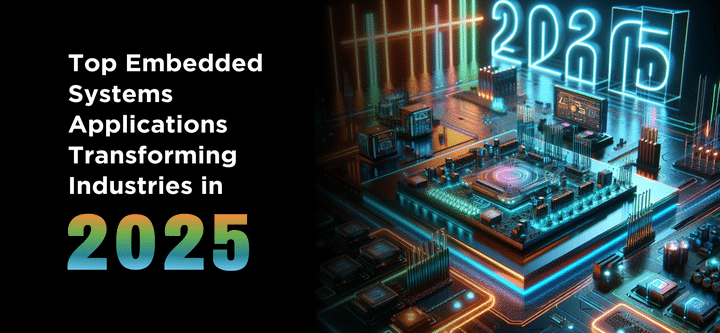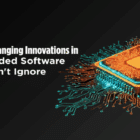In an era where technology seamlessly intertwines with our daily lives, embedded systems applications are becoming the backbone of countless innovations. These specialized computing systems are designed to perform dedicated functions within larger mechanical or electrical systems. From smart appliances in our homes to complex machinery in factories, their presence is felt across various sectors.
Understanding how these applications operate and transform industries opens a window into the future of technological advancement. Let’s dive into the fascinating world of embedded systems and explore their transformative impact on today’s industries!
What Are Embedded Systems Applications?
Embedded systems applications refer to specialized computing systems designed for specific tasks within a larger system. Unlike general-purpose computers, embedded systems are tailored for dedicated functions, ensuring efficiency, reliability, and precision. These systems integrate hardware and software seamlessly, operating in real-time to meet the unique demands of various applications.
At their core, embedded systems applications include microcontrollers, microprocessors, and associated firmware that enable devices to process data, communicate with other systems, and execute specific tasks autonomously. Their design focuses on low power consumption, compact form factors, and cost-effectiveness, making them ideal for integration into a wide range of products and services.
Embedded systems are not standalone entities; they form the foundation of transformative technologies. IoT (Internet of Things) relies heavily on embedded systems to connect and control devices, enabling real-time data exchange and remote management. For example, smart homes equipped with IoT devices use embedded systems to automate lighting, security, and climate control.
Similarly, Artificial Intelligence (AI) and Machine Learning (ML) leverage embedded systems for edge computing, where data is processed locally on devices rather than relying solely on cloud-based systems. This approach reduces latency and enhances real-time decision-making, which is critical in applications like autonomous drones and predictive maintenance systems.
Key Features of Embedded Systems Applications:
- Real-Time Operation: Designed to respond within strict time constraints, making them ideal for mission-critical applications.
- Energy Efficiency: Optimized for low power consumption, ensuring longer device lifespans and sustainability.
- Compact Design: Miniaturized components allow integration into even the smallest devices.
- Reliability: Built to operate consistently under various conditions, ensuring uninterrupted performance.
As the backbone of technological advancements, embedded systems are pivotal in driving innovation. They bridge the gap between physical devices and digital intelligence, enabling seamless communication, automation, and control across industries.
With the global embedded systems market expected to grow at a CAGR of 7.2% from 2023 to 2025, their importance in shaping the future cannot be overstated.
Examples of Embedded Systems Applications:
- Medical Devices: Microcontrollers in insulin pumps and pacemakers ensure precise dosage delivery and real-time monitoring.
- Smart Appliances: Firmware in refrigerators, washing machines, and HVAC systems enables automation and energy efficiency.
- Automotive Systems: Real-time operating systems (RTOS) in autonomous vehicles manage navigation, obstacle detection, Fintech products, and vehicle-to-vehicle communication.
- Consumer Electronics: Embedded systems power smartphones, smartwatches, and gaming consoles, delivering enhanced user experiences.
- Industrial Automation: Controllers in robotic arms and conveyor belts streamline manufacturing processes.
Why Embedded Systems Applications Matter
Embedded systems are not just about technology; they are about creating value. They enable:
- Operational Efficiency: Automation through embedded systems reduces human intervention, enhancing productivity.
- Cost Reduction: Optimized processes lead to significant cost savings.
- Enhanced User Experience: From intuitive interfaces to predictive analytics, embedded systems improve the end-user experience.
- Scalability and Flexibility: They allow businesses to scale their operations and adapt to changing market demands.
The global embedded systems market, valued at $104.6 billion in 2023, is projected to reach $163.2 billion by 2025, growing at a CAGR of 7.2%. This surge underscores their critical role in transforming industries.
Revolutionary Applications of Embedded Systems
Embedded systems are at the forefront of technological innovation, transforming industries in ways we once only imagined. These systems, which integrate hardware and software to perform specific functions, are driving advancements across various sectors, from healthcare to transportation. Let’s delve into the top industries where embedded systems are making waves and revolutionizing the way we live and work.
1. Smart Manufacturing: Industry 4.0’s Heartbeat
The adoption of Industry 4.0 has been accelerated by embedded systems. Smart sensors, real-time monitoring, and predictive maintenance are revolutionizing manufacturing processes. These systems enable factories to become more intelligent, adaptive, and efficient.
Statistics:
- By 2025, the global Industry 4.0 market is projected to reach $337 billion, growing at a CAGR of 16.5% from 2023.
- A PwC survey (2024) found that 72% of manufacturers plan to increase their investment in embedded IoT systems to enhance operational efficiency.
- Smart manufacturing driven by embedded systems can reduce production downtime by up to 30% and improve overall equipment effectiveness by 40% (McKinsey, 2024).
2. Healthcare: Precision and Care
In healthcare, embedded systems are driving innovation in patient care and operational efficiency. Devices such as insulin pumps, pacemakers, and diagnostic imaging tools rely on these systems for accuracy and reliability.
Statistics:
- The global healthcare embedded systems market is expected to grow at a CAGR of 9.8%, reaching $25 billion by 2025 (MarketWatch, October 2024).
- Wearable health devices, powered by embedded systems, are projected to exceed 500 million units sold globally by 2025, a 20% increase from 2023 (Statista, December 2024).
- According to Frost & Sullivan, embedded systems in healthcare can reduce diagnostic errors by 35% and improve patient outcomes by 25%.
3. Automotive: Driving Autonomy
The automotive industry is at the forefront of embedded systems innovation. From Advanced Driver Assistance Systems (ADAS) to fully autonomous vehicles, these systems are reshaping mobility and safety standards.
Statistics:
- The global automotive embedded systems market is expected to reach $60 billion by 2025, growing at a CAGR of 8.5% (Allied Market Research, November 2024).
- By 2025, 70% of new cars will feature Level 3 or higher autonomous capabilities (Statista, September 2024).
- Embedded systems in electric vehicles (EVs) are anticipated to grow by 12% annually, driven by the increasing adoption of EVs worldwide.
4. Renewable Energy: Powering the Future
Embedded systems are critical in managing renewable energy sources like solar and wind. Smart grids, energy storage systems, and real-time energy monitoring rely on these systems for efficient energy distribution.
Statistics:
- The renewable energy embedded systems market is forecasted to grow at a CAGR of 10% through 2025, driven by the global push for sustainability (IEA, 2024).
- Smart grid technology, which heavily depends on embedded systems, is expected to save $200 billion annually in energy costs by 2025 (World Economic Forum, 2024).
5. Retail: Smarter Shopping Experiences
From smart payment terminals to inventory management systems, embedded systems are revolutionizing retail operations. They enable real-time data analysis, enhancing customer experiences and operational efficiency.
Statistics:
- The global embedded systems market in retail is projected to grow by 7.3% annually, reaching $15 billion by 2025 (Grand View Research, 2024).
- Retailers using embedded systems for inventory management report a 20% reduction in stockouts and a 15% increase in sales efficiency (Retail Dive, 2024).
What the Future Holds for Embedded Systems and Its Applications
The future of embedded systems is intertwined with emerging technologies like AI, 5G, and quantum computing. Here are some trends to watch in 2025:
- Edge Computing: Embedded systems will process data locally, reducing latency and improving real-time decision-making.
- AI Integration: Smarter algorithms will enable predictive maintenance and enhanced automation.
- Sustainability: Energy-efficient designs will minimize environmental impact.
How Industries are Reaping the Benefits of Embedded Systems Applications
Industries across the board are leveraging embedded systems for competitive advantage. Key benefits include:
1. Improved Efficiency
Automation through embedded systems streamlines processes, ensuring tasks are completed faster and more accurately. This reduction in manual intervention not only decreases human errors but also boosts overall productivity, allowing companies to meet demand more effectively and improve customer satisfaction.
2. Cost Savings
Embedded systems enable businesses to optimize their resource usage by ensuring that equipment and processes run more efficiently. By minimizing waste, energy consumption, and operational disruptions, companies can significantly reduce costs while still maintaining high-quality output and performance.
3. Enhanced Innovation
With the flexibility and capabilities offered by embedded systems, businesses can develop groundbreaking products and services that were once out of reach. These systems enable the integration of advanced features like real-time data processing, machine learning, and IoT connectivity, driving continuous innovation in industries ranging from healthcare to automotive.
As Jack Welch famously said, “Change before you have to.” Embedded systems epitomize this ethos, driving change and innovation in industries worldwide.
How Evolute is Harnessing the Power of Embedded Systems Applications
Evolute Group excels in developing cutting-edge embedded systems across diverse domains, leveraging its expertise to deliver transformative solutions. In identity management, Evolute’s biometric and authentication devices provide robust, secure solutions for various applications. The group’s advanced energy storage solutions cater to industrial needs, EV mobility, and Battery Energy Storage Systems (BESS), ensuring sustainability and efficiency.
Its software solutions and services for payment and identity ecosystems streamline digital transactions and enhance security. Evolute’s expertise in EMS and allied services, coupled with ODM capabilities, supports complex manufacturing and design needs.
Additionally, its offerings in electronic and electromechanical components and modules, retail payment soundboxes, smart cloud printing platforms, and devices like Smart Payment POS, Micro ATMs, and thermal printers underscore its leadership in fintech and retail innovation. By combining advanced technology with a customer-centric approach, Evolute continues to redefine excellence in embedded solutions.
Conclusion: The Embedded System Applications Revolution
Embedded systems applications are not just transforming industries; they are shaping the future. To summarize:
- Embedded systems are critical in IoT, AI, and Industry 4.0.
- They drive efficiency, innovation, and sustainability.
- Key industries benefiting include manufacturing, healthcare, automotive, fintech, energy, and retail.
- The market is set to grow exponentially, fueled by technological advancements.
As a leader in embedded solutions, Evolute Group continues to empower industries with cutting-edge technologies, driving progress and sustainability.





